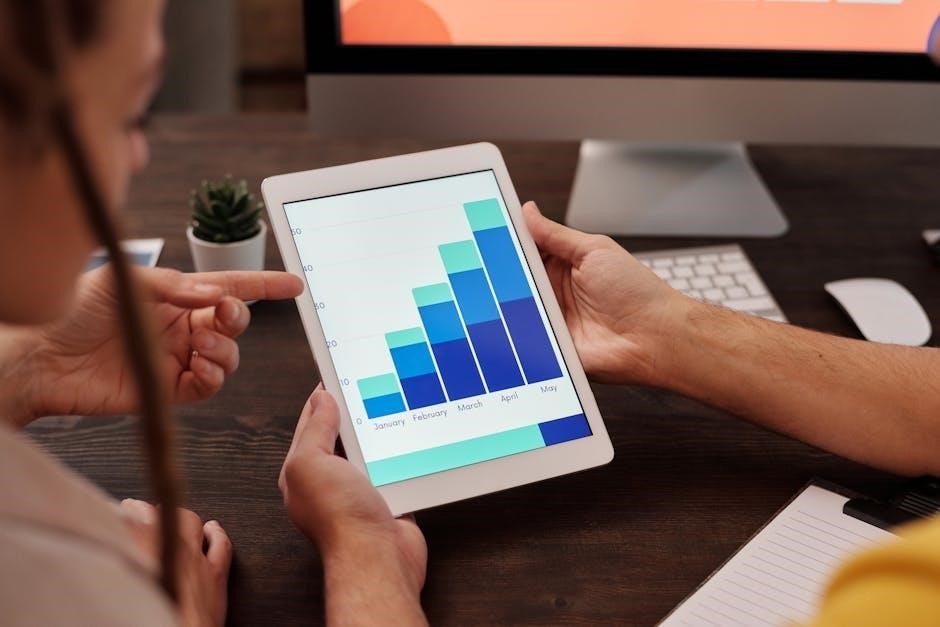how do you use data to drive instruction

Data-driven instruction uses student information to guide teaching strategies‚ ensuring decisions are informed by evidence․ By analyzing performance data‚ educators can identify needs‚ adjust lessons‚ and enhance learning outcomes effectively․
What is Data-Driven Instruction?
Data-driven instruction is an educational approach where teaching strategies are guided by student performance data․ It involves assessing student understanding through formative assessments and using the results to inform instructional decisions․ This dynamic method allows teachers to adapt their lessons based on real-time insights‚ addressing specific areas where students may need additional support․ By leveraging technology and analytical tools‚ educators can track progress and adjust their teaching methods accordingly․ Unlike traditional approaches‚ data-driven instruction emphasizes flexibility and personalization‚ aiming to enhance learning outcomes by making informed‚ evidence-based decisions․
Benefits of Data-Driven Instruction
Data-driven instruction enhances teaching effectiveness by providing insights into student performance‚ enabling personalized learning experiences․ It allows educators to identify learning gaps and tailor strategies to meet individual needs․ By leveraging real-time data‚ teachers can adjust instruction dynamically‚ improving student outcomes․ This approach fosters collaboration among stakeholders and ensures resources are used efficiently․ Ultimately‚ data-driven instruction aligns teaching with educational goals‚ leading to improved academic performance and better engagement․

Collecting and Assessing Data
Data-driven instruction begins with gathering and analyzing student performance data through formative assessments and checks for understanding‚ ensuring insights guide instructional decisions effectively;
Types of Data Used in Instruction
In data-driven instruction‚ educators use formative and summative assessments to gather insights․ Formative data‚ like quizzes and exit tickets‚ tracks progress during lessons‚ while summative data‚ such as tests‚ evaluates learning after instruction․ Additionally‚ progress monitoring data helps identify growth over time‚ and demographic data provides context about student backgrounds․ Together‚ these data types create a comprehensive understanding of student needs‚ enabling teachers to tailor strategies and improve outcomes effectively․
Formative Assessments and Checks for Understanding
Formative assessments are brief‚ informal tools used during instruction to measure student understanding․ Techniques include exit tickets‚ quizzes‚ and class discussions‚ providing immediate feedback․ Checks for understanding help teachers identify learning gaps and adjust instruction accordingly‚ ensuring personalized support․ These strategies allow educators to intervene early‚ fostering a more effective learning environment and improving student outcomes by addressing misconceptions promptly․ By integrating these practices‚ teachers can dynamically respond to student needs‚ enhancing engagement and academic success through data-driven decision-making․
Creating a Comprehensive Data Collection Plan
A comprehensive data collection plan involves systematically gathering diverse student data to inform instruction․ This includes formative assessments‚ summative tests‚ and performance metrics․ Teachers identify specific goals and outcomes‚ determining which data points are most relevant․ Regular intervals for data collection ensure progress monitoring is consistent․ Tools like digital quizzes and class discussions provide actionable insights․ The plan also outlines how data will be analyzed and shared among stakeholders․ By aligning data collection with instructional goals‚ educators can make informed decisions‚ ensuring targeted support for all learners․ This structured approach transforms raw data into a powerful tool for improving student outcomes and teaching strategies․

Analyzing and Interpreting Data
Analyzing data reveals patterns‚ enabling educators to identify student strengths and weaknesses‚ and informing tailored instructional strategies for continuous improvement and enhanced learning outcomes․
How to Analyze Student Performance Data
Analyzing student performance data involves identifying trends‚ strengths‚ and gaps․ Teachers use formative assessments‚ pretests‚ and digital tools to gather insights‚ then categorize students by needs․ This process helps tailor instruction‚ ensuring targeted support and differentiated strategies․ By monitoring progress and adjusting teaching methods‚ educators ensure all learners meet their goals effectively․
Identifying Learning Gaps and Areas of Improvement
Identifying learning gaps involves analyzing performance data to pinpoint areas where students struggle․ Teachers use formative assessments‚ pretests‚ and digital quizzes to uncover weaknesses․ By comparing student results to learning goals‚ educators can spot patterns and determine which concepts require reteaching․ Data insights help differentiate instruction‚ allowing teachers to design targeted interventions and personalized learning plans․ This process ensures no student falls behind‚ addressing specific needs and fostering academic growth․ Regular progress monitoring and adjustments to instruction further refine teaching strategies‚ ensuring all learners achieve their full potential․
Using Data to Inform Instructional Decisions
Using data to inform instructional decisions involves analyzing student performance to guide teaching strategies․ Educators review assessment results to identify strengths and weaknesses‚ then adjust lesson plans accordingly․ Data helps determine which concepts need reteaching and informs the creation of targeted interventions․ By aligning instruction with student needs‚ teachers can address learning gaps and enhance engagement․ Data also supports differentiated instruction‚ allowing for personalized learning plans․ Collaborative teacher meetings and progress monitoring further refine these strategies‚ ensuring that instructional decisions are evidence-based and tailored to improve student outcomes effectively․

Data-Driven Instructional Strategies
Data-driven instruction involves analyzing student performance to identify learning gaps and tailor teaching strategies․ By assessing progress‚ educators adjust lessons‚ target interventions‚ and personalize instruction‚ ensuring effective student support and improved outcomes․
Differentiated Instruction Based on Data Insights
Data insights enable teachers to differentiate instruction by identifying individual student strengths‚ weaknesses‚ and learning styles․ By analyzing performance data‚ educators can create targeted groups‚ tailor resources‚ and adjust pacing to meet diverse needs․ This approach ensures personalized learning experiences‚ fostering academic growth and engagement․ Teachers can also use formative assessments to monitor progress and adapt instruction in real-time‚ addressing specific skill gaps․ Data-driven differentiation empowers educators to make informed decisions‚ ensuring no student is left behind and maximizing learning potential․ This strategy promotes equity and effectiveness in the classroom‚ aligning instruction with student needs for optimal outcomes․
Personalized Learning Approaches
Personalized learning uses data to tailor instruction to individual student needs‚ interests‚ and learning styles․ By analyzing performance data‚ educators identify strengths and areas for growth‚ enabling targeted interventions․ Learning analytics and formative assessments provide insights to adjust instruction‚ ensuring each student receives relevant support․ Technology tools‚ such as AI‚ help customize resources and pacing‚ fostering engagement and efficiency․ Personalized approaches empower students to take ownership of their learning‚ setting goals and tracking progress․ This data-driven strategy ensures equitable opportunities for all learners‚ regardless of ability‚ and maximizes academic growth by addressing unique needs in real-time․
Integrating Technology into Instruction
Technology enhances data-driven instruction by providing tools to collect‚ analyze‚ and act on student data․ Learning management systems (LMS) and educational software offer real-time insights‚ enabling teachers to track progress and identify gaps․ AI tools personalize learning by adapting content to individual needs‚ while data analytics platforms help visualize trends for informed decision-making․ Additionally‚ digital assessments and quizzes facilitate frequent checks for understanding‚ allowing immediate adjustments to instruction․ Technology also supports collaboration‚ enabling teachers to share data and strategies․ By integrating these tools‚ educators create a dynamic‚ responsive learning environment that leverages data to optimize teaching and improve student outcomes effectively and efficiently․

Monitoring Student Progress
Monitoring student progress involves systematically tracking learning through formative assessments and data analysis․ This informs instructional adjustments‚ ensures alignment with goals‚ and supports continuous improvement in student outcomes․
Setting SMART Goals for Student Achievement
Setting SMART (Specific‚ Measurable‚ Achievable‚ Relevant‚ Time-bound) goals is crucial for guiding data-driven instruction․ Teachers use student data to define clear objectives‚ ensuring goals align with learning standards and address individual needs․ By establishing measurable targets‚ educators can track progress systematically․ For instance‚ a SMART goal might aim to improve reading proficiency by 20% within a semester․ Regular assessments and progress monitoring help adjust instruction‚ keeping students on track․ This approach ensures goals are realistic and attainable‚ fostering accountability and continuous improvement in student achievement․
Continuous Progress Monitoring
Continuous progress monitoring involves regularly tracking student learning to assess growth and guide instruction․ Teachers use formative assessments‚ quizzes‚ and performance data to measure progress toward goals․ By frequently checking for understanding‚ educators can identify learning gaps early and adjust strategies․ This ongoing process ensures that instruction remains aligned with student needs‚ fostering timely interventions․ Regular data reviews help teachers refine lessons‚ providing targeted support where needed․ Continuous monitoring not only enhances accountability but also ensures that students stay on track to meet academic objectives‚ making data-driven instruction more dynamic and responsive to individual and classroom needs throughout the learning process․
Adjusting Instruction Based on Progress Data
Adjusting instruction based on progress data ensures teaching strategies remain effective and relevant․ By analyzing performance trends‚ educators can identify areas where students excel or struggle‚ allowing for timely modifications․ This might involve reteaching concepts‚ differentiating instruction‚ or integrating new resources․ Data insights help teachers pivot their approaches‚ ensuring all learners receive targeted support․ Regular adjustments foster a responsive learning environment‚ keeping students engaged and on track to meet goals․ This iterative process enhances instructional effectiveness‚ ensuring that teaching methods evolve in response to student needs‚ ultimately improving academic outcomes and fostering a culture of continuous improvement in the classroom․

Technology Tools to Support Data-Driven Instruction
Technology tools like learning analytics and AI enable educators to collect‚ analyze‚ and act on data‚ personalizing instruction and enhancing student outcomes through real-time insights and tailored strategies․
Learning Analytics and Their Role
Learning analytics play a crucial role in data-driven instruction by transforming raw student data into actionable insights․ These tools analyze performance metrics to identify learning gaps and strengths‚ enabling educators to tailor instruction to individual needs․ By providing real-time feedback‚ analytics help teachers adjust strategies‚ ensuring timely interventions․ This approach supports personalized learning and informs resource allocation․ Ultimately‚ learning analytics empower educators to make informed decisions‚ fostering a more adaptive and effective teaching environment․ Their integration into classrooms enhances the ability to track progress and improve outcomes‚ making data-driven instruction more precise and impactful for student success․ Technology scales these efforts seamlessly․
Data Management Systems for Educators
Data management systems empower educators to organize‚ analyze‚ and interpret student data efficiently․ These tools streamline the collection of performance metrics‚ attendance‚ and progress‚ enabling teachers to make informed decisions․ By centralizing data‚ educators can track learning trends‚ identify gaps‚ and tailor instruction to meet individual needs․ Customizable reports and real-time insights allow for timely interventions․ These systems also facilitate collaboration among teachers‚ fostering a culture of data-driven decision-making․ Effective data management ensures that educators can focus on instructional strategies‚ ultimately enhancing student outcomes and academic success․ Such systems are essential for modern classrooms‚ providing the framework to leverage data for meaningful impact․
AI Tools for Personalized Instruction
AI tools revolutionize personalized instruction by analyzing vast amounts of student data to identify learning gaps and strengths․ These tools provide tailored resources and real-time feedback‚ enabling teachers to adapt instruction to individual needs․ AI-driven platforms can generate customized lesson plans‚ recommend adaptive learning paths‚ and predict student performance․ By automating data analysis‚ AI tools save educators time‚ allowing them to focus on teaching․ They also enhance engagement through interactive and dynamic learning experiences․ Ultimately‚ AI tools empower educators to deliver more effective‚ targeted instruction‚ fostering student success and academic growth in a scalable and efficient manner․

Professional Development for Educators
Professional development equips educators with skills to analyze data‚ informing instruction and improving student outcomes through targeted strategies‚ collaborative planning‚ and evidence-based decision-making․
Training in Data-Driven Decision Making
Training in data-driven decision making empowers educators to effectively collect‚ analyze‚ and interpret student data‚ enabling informed instructional strategies․ Workshops and resources provide teachers with tools to transform data into actionable insights‚ fostering a culture of evidence-based practices․ Collaborative activities encourage educators to share strategies‚ aligning data with curriculum goals․ By mastering these skills‚ teachers can identify learning gaps‚ personalize instruction‚ and monitor progress‚ ultimately enhancing student outcomes․ This professional development ensures educators are equipped to make data-informed decisions‚ supporting continuous improvement in teaching and learning․
Collaborative Teacher Meetings and Planning
Collaborative teacher meetings and planning are essential for leveraging data to drive instruction․ Educators brainstorm instructional strategies‚ align data with curriculum goals‚ and share insights to address student needs․ These sessions foster a culture of accountability and continuous improvement‚ ensuring data informs teaching practices․ By discussing progress and challenges‚ teachers refine their approaches‚ enhancing student outcomes․ Collaborative planning also promotes consistency across classrooms‚ ensuring aligned strategies and shared responsibilities․ Regular meetings help educators stay focused on data-driven goals‚ fostering a collective commitment to student success and personalized learning experiences․
The Role of Data Champions
Data champions play a crucial role in promoting data-driven instruction by guiding educators in using student information effectively․ They ensure the right data is collected and analyzed‚ aligned with instructional goals․ Champions facilitate professional development‚ helping teachers interpret data and implement strategies․ They foster collaboration‚ encouraging educators to share insights and best practices․ By providing support and resources‚ data champions empower teachers to make informed decisions‚ ultimately enhancing student outcomes․ Their leadership ensures a data-driven culture is sustained‚ helping schools achieve their educational objectives through evidence-based practices and continuous improvement․

Addressing Barriers to Implementation
Time constraints and data privacy concerns are key barriers․ Streamlining processes and ensuring secure data handling can help educators effectively use data to drive instruction․
Overcoming Time Constraints
Time constraints can hinder data-driven instruction‚ but strategies like streamlining data collection and prioritizing high-impact assessments can help․ Automating data analysis through technology tools saves time‚ allowing educators to focus on instruction․ Professional development programs can also equip teachers with efficient methods for data interpretation․ By integrating data analysis into existing workflows and collaborative planning sessions‚ educators can maximize efficiency․ Providing time during meetings for data review ensures consistency without overwhelming staff․ These approaches help balance the demands of data-driven instruction with the practical realities of limited time‚ making it feasible to implement effectively․
Ensuring Data Privacy and Security
Protecting student data is critical in data-driven instruction․ Schools must comply with regulations like FERPA to safeguard personal information․ Implementing encryption‚ secure data storage‚ and role-based access ensures only authorized personnel can view sensitive data․ Regular audits and training for staff on data handling practices are essential․ Transparent communication with parents about data use builds trust․ By prioritizing privacy and security‚ educators can confidently use data to inform instruction while maintaining ethical standards and legal compliance‚ ensuring a safe and responsible approach to leveraging student information for improved learning outcomes․

Best Practices for Effective Data Use
Start small‚ focus on key metrics‚ and foster collaboration among stakeholders․ Continuous improvement through data ensures sustainable growth and informed decision-making in education․
Starting Small and Building Capacity
Starting small involves implementing manageable strategies‚ like pretesting or digital quizzes‚ to gather initial data․ This approach helps educators build confidence and skills gradually․ By focusing on specific metrics and scaling efforts over time‚ schools can create a culture of data-driven decision-making․ Empowering teachers with professional development and collaborative planning fosters a sustainable approach․ Celebrating early successes motivates stakeholders to continue advancing data use․ This incremental method ensures that data-driven instruction becomes a natural part of the educational process‚ leading to long-term improvements in teaching and learning outcomes․
Fostering Collaboration Among Stakeholders
Collaboration among teachers‚ administrators‚ and parents is key to data-driven instruction․ Regular meetings allow educators to analyze data‚ brainstorm strategies‚ and align goals․ Open communication ensures everyone understands student needs and progress․ By involving all stakeholders‚ schools create a unified approach to improving outcomes․ Data sharing and joint decision-making foster accountability and trust․ This collective effort ensures that instructional changes are supported and sustained‚ leading to a more effective and cohesive educational environment․ Collaboration strengthens the impact of data use‚ benefiting both teachers and students alike․ It promotes a culture of shared responsibility and continuous improvement in education․
Continuous Improvement Through Data
Continuous improvement through data involves regularly analyzing and acting on student performance data to refine instructional strategies․ By identifying trends and areas of growth‚ educators can adjust teaching methods to better meet student needs․ This iterative process ensures that instruction remains dynamic and responsive‚ leading to enhanced learning outcomes․ Data-driven continuous improvement fosters a culture of ongoing refinement‚ where educators collaborate to address learning gaps and implement evidence-based practices․ This approach not only supports individual student progress but also contributes to systemic improvements across the educational environment‚ ensuring that all learners have the opportunity to succeed and thrive․

Future Trends in Data-Driven Instruction
Future trends in data-driven instruction include advancements in AI‚ real-time analytics‚ and enhanced personalized learning‚ enabling educators to make more informed‚ dynamic decisions․
Advancements in Artificial Intelligence
Advancements in Artificial Intelligence (AI) are revolutionizing data-driven instruction by enabling personalized learning experiences․ AI tools analyze vast amounts of student data to identify learning patterns‚ strengths‚ and weaknesses‚ allowing teachers to tailor instruction to individual needs․ Automated systems can generate customized lesson plans‚ adaptive assessments‚ and real-time feedback‚ enhancing engagement and outcomes․ AI-powered platforms also support educators in identifying at-risk students early‚ enabling proactive interventions․ Additionally‚ AI facilitates efficient data management and visualization‚ helping teachers make informed decisions quickly․ These innovations are transforming education‚ making data-driven instruction more precise‚ efficient‚ and impactful for all learners․
Real-Time Data Analytics
Real-time data analytics empowers educators to monitor student progress instantaneously‚ enabling immediate instructional adjustments․ By leveraging live data from quizzes‚ assignments‚ and interactions‚ teachers can identify gaps and adapt lessons dynamically․ This approach fosters a responsive learning environment‚ where interventions are timely and targeted․ Real-time insights also enhance collaboration among educators‚ allowing them to share strategies and resources effectively․ Furthermore‚ real-time analytics support personalized learning‚ ensuring each student receives the support they need․ This capability is transforming education by making data-driven instruction more agile‚ student-centered‚ and ultimately‚ more effective in improving academic outcomes and engagement across diverse learning settings․
Data-driven instruction transforms education by enabling informed decisions‚ personalized learning‚ and continuous improvement․ By leveraging insights‚ educators can enhance outcomes‚ fostering a culture of data-informed excellence and student success․
Transformative Impact on Education
Data-driven instruction revolutionizes education by empowering educators with actionable insights‚ enabling personalized learning and improved outcomes․ By leveraging student data‚ teachers identify learning gaps and strengths‚ tailoring instruction to meet diverse needs․ This approach fosters engagement‚ accelerates progress‚ and ensures equitable opportunities for all learners․ It shifts the focus from traditional methods to dynamic‚ data-informed strategies‚ enhancing the overall quality of education․ Schools that embrace this approach experience systemic improvements‚ as collaboration and continuous improvement become ingrained in their culture․ Ultimately‚ data-driven instruction aligns teaching with student needs‚ creating a more responsive and effective educational system that prepares students for future success․



